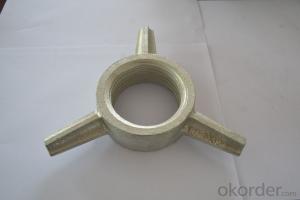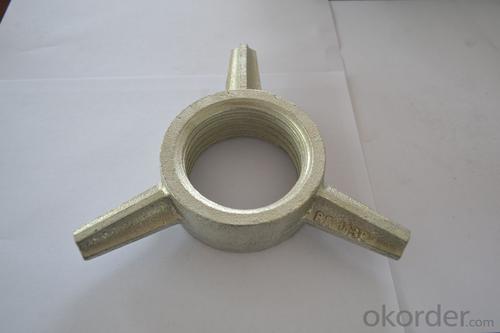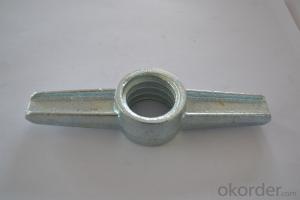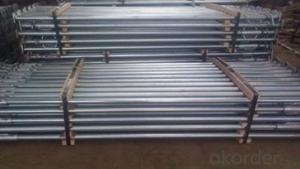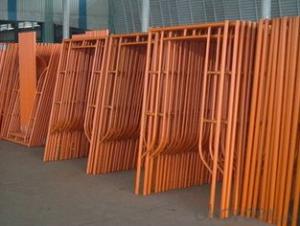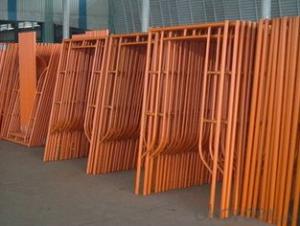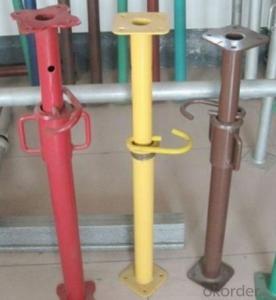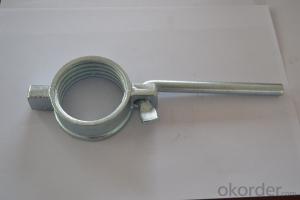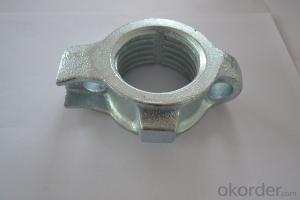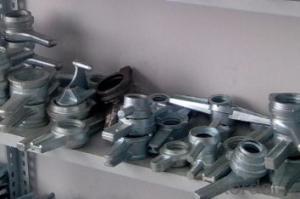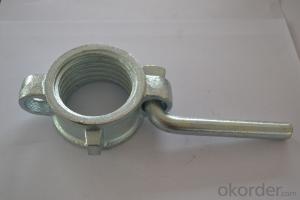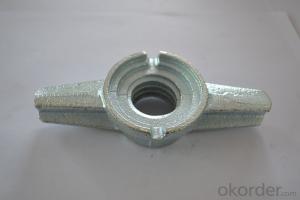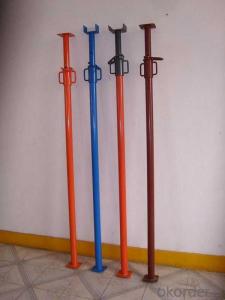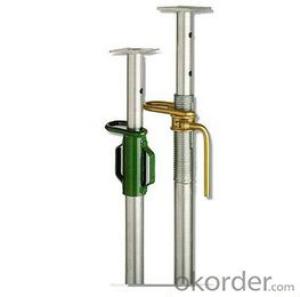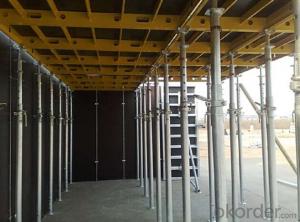OEM Two wing Butterfly Wing Nuts 9
- Loading Port:
- China Main Port
- Payment Terms:
- TT OR LC
- Min Order Qty:
- -
- Supply Capability:
- -
OKorder Service Pledge
OKorder Financial Service
You Might Also Like
Quick Details
| Model Number: | |||||
| Standard: | Type: | Certification: | |||
| Material: | Surface: |
Packaging & Delivery
| Packaging Detail: | Plastic bag, pallet packing, carton box, by customer's requirement |
| Delivery Detail: | within 30days after payment |
Specifications
Two wing Butterfly Wing Nuts
1>Excellent dimension accuracy
2>Finished: per your requirements
3>factory directly supply
Two wing Butterfly Wing Nuts
We supply kinds of metal parts totally according to clients' drawings and samples and special requirement.
1. Material: Ductile iron .
2. Sizes: Inner hole Dia 15/17mm.
We have different sizes ,types of wing nut to meet your needs, save your cost .
3. Weight: 0.35kg,thread pitch: 10.0mm.(or 6.35mm)
4. Surface: White Zinic , Yellow Zinic or painted, self color
5 Thread:casted or machine tap.
1. 12000M2 standard modern workshop guarantee production capability to satisfy the customers needs
2. Our Independent quality control department,Which make sure the quality of all products
3. Our efficient and experienced sales team ,provide friendly and thoughtful service for clients from all over the world
- Q: Can steel props be used for supporting temporary seating structures?
- Yes, steel props can be used for supporting temporary seating structures. Steel props are commonly used in construction to provide temporary support and stability. They are strong, durable, and adjustable, making them suitable for holding up temporary seating structures and ensuring the safety of the occupants.
- Q: Can steel props be used for temporary support during suspended ceiling installation?
- Yes, steel props can be used for temporary support during suspended ceiling installation. Steel props are commonly used in construction as temporary supports to provide stability and safety during various construction activities. They are adjustable in height and can withstand heavy loads, making them suitable for supporting the weight of suspended ceilings. Steel props are reliable and durable, ensuring that the suspended ceiling remains securely in place during installation. Additionally, their adjustable nature allows for precise leveling and alignment, ensuring a professional and accurate installation. Therefore, steel props are a suitable choice for temporary support during suspended ceiling installation.
- Q: What are the typical diameters of steel props?
- The typical diameters of steel props range from 40mm to 60mm, depending on the specific requirements of the construction project.
- Q: What safety precautions should be taken while using steel props?
- To ensure the well-being of workers and prevent accidents, certain safety precautions must be taken when using steel props. The following are some safety measures that should be implemented: 1. Thorough training is necessary for workers to understand the correct usage, assembly, and disassembly of steel props. Additionally, they should receive education on potential hazards and how to mitigate them. 2. Before utilizing steel props, a detailed inspection should be conducted to identify any signs of damage, such as cracks, bends, or rust. Faulty props should never be utilized, as they can compromise safety. 3. It is crucial to assess the load capacity of the steel props and ensure that it is not exceeded. Overloading can lead to collapse or failure, resulting in serious injuries or even fatalities. 4. Steel props should be securely positioned and braced to prevent accidental movement or collapse during use. They should be installed on a stable and level surface, employing any necessary shoring or bracing techniques. 5. Regular maintenance and inspections should be carried out to identify and address any wear and tear or potential issues with the steel props. This includes lubricating moving parts, checking for loose or damaged components, and replacing worn-out parts. 6. Workers must always wear appropriate personal protective equipment (PPE) such as safety helmets, steel-toed boots, gloves, and eye protection. This ensures protection from potential falling objects or debris. 7. Effective communication and coordination among workers are essential for the safe use of steel props. Clear instructions should be provided, and workers should be aware of their roles and responsibilities. 8. Workers should be familiar with emergency procedures and have access to first aid kits and fire extinguishers. In case of an emergency, they should know how to safely evacuate the area. By adhering to these safety precautions, the risk of accidents, injuries, and property damage can be significantly reduced when using steel props. Safety should always be prioritized, and workers should be adequately trained and equipped to handle the equipment correctly.
- Q: Are steel props suitable for use in railway tunnel construction?
- Steel props are indeed suitable for railway tunnel construction. Their strength and durability make them an excellent choice for supporting the tunnel structure during construction. Not only do they provide stability, but they can also withstand the high loads and pressures commonly faced in tunneling projects. Moreover, steel props offer the advantage of adjustability, facilitating effortless installation and removal as construction advances. Due to their versatility and reliability, they are widely favored for railway tunnel construction.
- Q: Can steel props be used for supporting temporary awnings or canopies?
- Temporary awnings or canopies can be supported using steel props. These props, also known as adjustable steel props or steel shore props, are commonly utilized in construction to provide temporary support to structures. They can be easily installed and removed as needed, and their height can be adjusted. Steel props offer numerous benefits when it comes to supporting temporary awnings or canopies. Firstly, they are strong and sturdy, capable of bearing heavy loads. This ensures stability and safety by supporting the weight of the awning or canopy. Moreover, steel props can be adjusted to the desired height, allowing for flexibility in installation. This is particularly advantageous when dealing with uneven ground or structures of varying heights. With their adjustable feature, steel props can be modified effortlessly to provide the necessary support and ensure a level and secure installation. Furthermore, steel props are durable and weather-resistant, making them suitable for outdoor use. They can withstand various weather conditions, including wind, rain, and even snow, protecting the awning or canopy from damage and keeping it securely in place. In conclusion, steel props are a reliable and versatile solution for supporting temporary awnings or canopies. Their strength, adjustability, and durability make them an ideal choice for providing stable and secure support to these structures.
- Q: Are steel props suitable for use in the construction of bridges?
- Yes, steel props are suitable for use in the construction of bridges. Steel props provide structural support and stability during bridge construction, offering high load-bearing capacity and durability. They can be adjusted and customized to accommodate various bridge designs and load requirements, making them an ideal choice for bridge construction projects.
- Q: How do you properly set up a steel prop?
- To ensure stability and safety, there are several key steps involved in properly setting up a steel prop. Follow this guide to ensure a proper setup: 1. Evaluate load-bearing requirements: Before setting up the steel prop, it is crucial to assess the weight and load it will bear. This evaluation will help determine the appropriate prop size and capacity needed for the job. 2. Select the appropriate prop: Choose a steel prop that meets the load-bearing requirements determined in step one. Consider factors such as prop height adjustment range, weight capacity, and overall durability. 3. Prepare the area: Clear the designated area of any debris, obstacles, or loose materials that could compromise stability. Ensure the ground is level and solid to provide a sturdy foundation. 4. Adjust the prop's height: Extend the steel prop to the desired height by turning the adjustment collar. Make sure the collar is securely tightened to avoid accidental retraction during use. 5. Place the prop correctly: Position the steel prop at the desired location, ensuring it is perpendicular to the ground and aligned with the load-bearing point. Use a spirit level, if necessary, to check for vertical alignment. 6. Secure the prop: Once the prop is correctly positioned, secure it in place. This can be done by using adjustable steel plates or timber needles to provide additional support and prevent movement. 7. Check for stability: Gently apply pressure to the prop to inspect its stability and ensure it can bear the anticipated load. If any instability is detected, adjust the prop's height or reposition it until it is secure. 8. Regularly monitor and maintain: Throughout the project, it is crucial to regularly monitor the prop's stability. Inspect for signs of wear, damage, or shifting, and address any issues immediately. Additionally, avoid exceeding the prop's recommended capacity. Remember, proper setup of a steel prop is essential for project success and the safety of workers and the surrounding environment. Always follow manufacturer guidelines and local regulations when working with steel props to ensure a secure and stable setup.
- Q: What is the maximum spacing between steel props?
- Various factors, such as the load capacity of the props, the dimensions of the structure, and the project requirements, influence the maximum spacing between steel props. However, engineering calculations and recommendations from the manufacturer or industry standards generally determine this spacing. The purpose of steel props is to offer temporary support during construction or renovation, guaranteeing the stability and integrity of the structure. Thus, it is crucial to appropriately space the props, ensuring effective load distribution and preventing any potential structural failures or collapses. Engineers consider the load weight and distribution, material properties, structure dimensions, prop type, and any supplementary support or reinforcement measures when determining the maximum spacing between steel props. To determine the maximum spacing for a specific project, it is vital to consult with a qualified structural engineer or adhere to the manufacturer's guidelines. This ensures the safety and stability of the supported structure.
- Q: Can steel props be used for supporting temporary structures during disaster relief efforts?
- Yes, steel props can be used for supporting temporary structures during disaster relief efforts. Steel props provide sturdy and reliable support, making them suitable for holding up temporary structures such as tents, shelters, or makeshift medical facilities in disaster-stricken areas. The strength and durability of steel make it a preferred choice for ensuring the stability and safety of structures in challenging environments.
Send your message to us
OEM Two wing Butterfly Wing Nuts 9
- Loading Port:
- China Main Port
- Payment Terms:
- TT OR LC
- Min Order Qty:
- -
- Supply Capability:
- -
OKorder Service Pledge
OKorder Financial Service
Similar products
Hot products
Hot Searches
Related keywords
